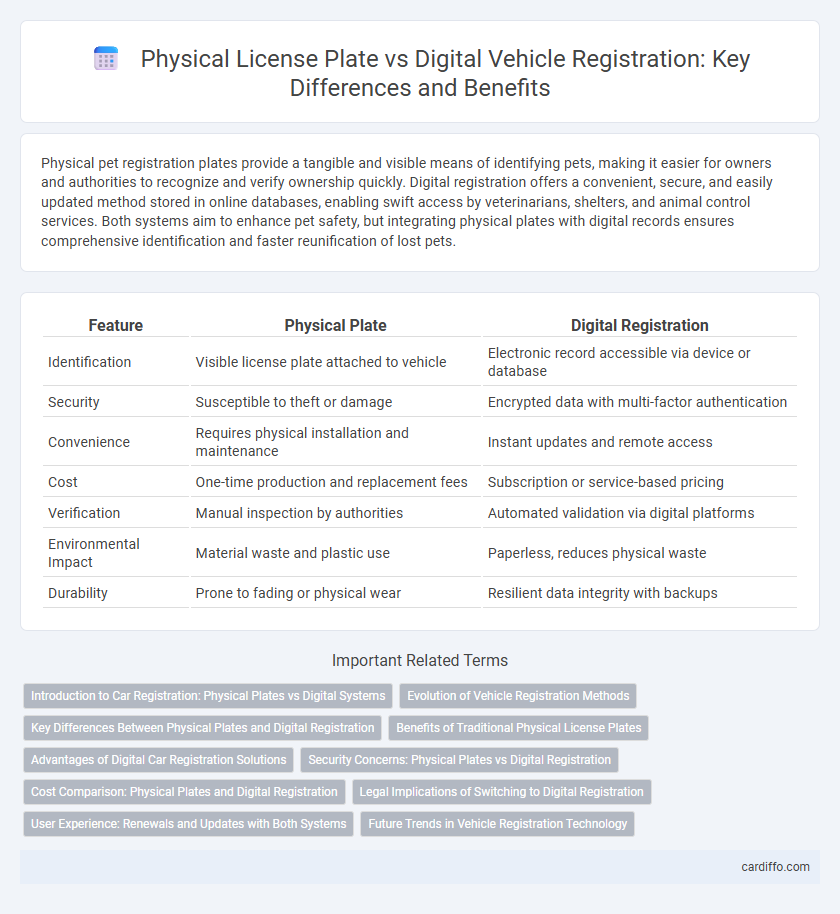Physical pet registration plates provide a tangible and visible means of identifying pets, making it easier for owners and authorities to recognize and verify ownership quickly. Digital registration offers a convenient, secure, and easily updated method stored in online databases, enabling swift access by veterinarians, shelters, and animal control services. Both systems aim to enhance pet safety, but integrating physical plates with digital records ensures comprehensive identification and faster reunification of lost pets.
Table of Comparison
| Feature | Physical Plate | Digital Registration |
|---|---|---|
| Identification | Visible license plate attached to vehicle | Electronic record accessible via device or database |
| Security | Susceptible to theft or damage | Encrypted data with multi-factor authentication |
| Convenience | Requires physical installation and maintenance | Instant updates and remote access |
| Cost | One-time production and replacement fees | Subscription or service-based pricing |
| Verification | Manual inspection by authorities | Automated validation via digital platforms |
| Environmental Impact | Material waste and plastic use | Paperless, reduces physical waste |
| Durability | Prone to fading or physical wear | Resilient data integrity with backups |
Introduction to Car Registration: Physical Plates vs Digital Systems
Car registration involves linking vehicle ownership with government records through physical plates or digital systems. Physical plates serve as tangible identification displayed on vehicles, while digital registration systems use electronic databases and mobile apps for real-time access and updates. Digital systems enhance convenience, reduce administrative errors, and support law enforcement through instant verification capabilities.
Evolution of Vehicle Registration Methods
Vehicle registration methods have evolved from traditional physical license plates to digital registration systems that enhance convenience and security. Physical plates provide a tangible identification method, while digital registration leverages electronic databases and mobile apps for real-time updates and streamlined enforcement. This transition supports faster vehicle verification and reduces administrative overhead in modern transportation management.
Key Differences Between Physical Plates and Digital Registration
Physical plates offer a tangible, durable form of vehicle identification that is easily visible and widely accepted by law enforcement and regulatory authorities. Digital registration leverages electronic records, enabling instant updates, remote access, and integration with smart vehicle technologies for enhanced convenience and real-time monitoring. Key differences include the physical presence and visibility of plates versus the virtual, data-driven nature of digital registration systems, impacting enforcement, convenience, and administrative efficiency.
Benefits of Traditional Physical License Plates
Traditional physical license plates offer durability and visibility under various weather conditions, ensuring consistent vehicle identification. They provide a tangible, easily recognizable form for law enforcement and toll systems, enhancing security and enforcement measures. Physical plates also reduce dependency on digital infrastructure, minimizing risks associated with electronic failures or hacking.
Advantages of Digital Car Registration Solutions
Digital car registration solutions offer increased convenience by allowing vehicle owners to complete the process online without visiting a physical office. These systems provide faster processing times and reduce paperwork, minimizing human error and streamlining data management. Enhanced accessibility through digital platforms ensures real-time updates, secure document storage, and easy retrieval compared to traditional physical plates and registrations.
Security Concerns: Physical Plates vs Digital Registration
Physical plates face security risks such as theft, cloning, and tampering due to their tangible nature, making them vulnerable to unauthorized use and fraud. Digital registration systems leverage encryption, biometric verification, and secure cloud storage to mitigate these risks, enhancing data integrity and user authentication. However, digital platforms require robust cybersecurity measures to prevent hacking, data breaches, and identity theft.
Cost Comparison: Physical Plates and Digital Registration
Physical plates often incur higher costs due to manufacturing, shipping, and installation fees, typically ranging from $20 to $100 depending on the region. Digital registration reduces expenses by eliminating the need for physical materials and enabling instant access, with costs primarily associated with software maintenance and digital infrastructure. Budget analyses show digital registration can save governments and users up to 50% compared to traditional physical plates over time.
Legal Implications of Switching to Digital Registration
Switching from physical plates to digital vehicle registration raises significant legal implications, including ensuring compliance with state-specific laws governing digital proof of ownership and display requirements. Digital registration systems must incorporate robust cybersecurity measures to prevent fraud and unauthorized access, addressing legal concerns related to data protection and privacy. Courts and law enforcement agencies require clear legal frameworks validating digital registrations to maintain enforceability and avoid disputes over vehicle identity and registration status.
User Experience: Renewals and Updates with Both Systems
Physical plate registration requires vehicle owners to visit DMV offices for renewals and updates, often resulting in longer wait times and administrative delays. Digital registration systems enable seamless online renewals and instant updates, enhancing convenience and reducing processing times. Users benefit from real-time notifications and easy access to updated registration information, improving overall satisfaction.
Future Trends in Vehicle Registration Technology
Physical plates have dominated vehicle identification for over a century, but digital registration systems are rapidly evolving with advancements in IoT and blockchain technology. Future trends include the integration of digital license plates capable of displaying real-time information, enhancing security and enabling remote updates. Enhanced data analytics and AI-driven systems will streamline registration processes, reducing fraud and improving law enforcement efficiency.
Physical Plate vs Digital Registration Infographic

 cardiffo.com
cardiffo.com